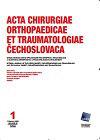镁基植入物固定儿童膝关节骨软骨损伤。
IF 0.4
4区 医学
Q4 ORTHOPEDICS
Acta chirurgiae orthopaedicae et traumatologiae Cechoslovaca
Pub Date : 2023-04-01
DOI:10.55095/achot2023/014
引用次数: 0
摘要
骨软骨碎片的固定是儿科骨科手术中相对常见的手术。在这些适应症中使用可生物降解的镁植入物似乎是聚合物植入物的一种有前途的替代品,因为它们具有良好的机械性能和生物行为。本研究的目的是评估儿童患者使用MAGNEZIX®螺钉和销钉固定膝关节不稳定或移位的骨软骨骨折和剥脱性骨软骨炎病变的短期临床和放射学结果。材料和方法在本研究中,包括12名患者(5名女孩,7名男孩)。纳入标准如下:(1)年龄在18岁以下;(2) 创伤继发或剥脱性骨软骨炎引起的不稳定或移位的骨软骨碎片,ICRS(国际软骨修复学会)评分中的III级和IV级,通过成像方法确认,并适合手术固定;(3) 使用镁基MAGNEZIX®合金制成的螺钉或销钉进行固定;(4) 最小术后间隔12个月。术后1天、6周、3个月、6个月和12个月进行X光检查和临床评估。术后1年进行核磁共振成像,以评估植入物的骨反应和降解行为。结果平均手术年龄为13.3±1.6岁。11名患者共使用了25枚螺钉,平均每位患者2.4±1枚,1名患者使用了4枚销钉。在2例患者中,螺钉固定辅以纤维蛋白胶。平均随访14.2±3.3个月。术后6个月,所有患者均表现出完全的功能恢复,但没有疼痛迹象。未观察到局部不良反应。在1年的随访中,没有植入失败的报告。12例影像学检查完全治愈。在植入物周围观察到轻微的射线透射区。结论已发现使用螺钉和销钉MAGNEZIX®在骨折愈合方面提供了令人满意的结果,并在术后1年提供了非常好的功能结果。关键词:可生物降解植入物,镁基植入物,骨软骨骨折,剥脱性骨软骨炎,MAGNEZIX®。本文章由计算机程序翻译,如有差异,请以英文原文为准。
Fixation of Knee Osteochondral Lesions in Pediatric Patients with Magnesium-Based Implants.
PURPOSE OF THE STUDY Fixation of osteochondral fragments are relatively common procedures in pediatric orthopaedic surgery. The use of biodegradable magnesium implants in these indications appears to be a promising alternative to polymer implants due to their favorable mechanical properties and biological behavior. The purpose of this study is to evaluate the short-term clinical and radiological outcomes of the fixation of unstable or displaced osteochondral fractures and osteochondritis dissecans lesions in the knee joint using MAGNEZIX® screws and pins in pediatric patients. MATERIAL AND METHODS In this study, 12 patients (5 girls, 7 boys) were included. The inclusion criteria were as follows (1) age below 18 years; (2) unstable or displaced osteochondral fragments secondary to trauma or as a result of osteochondritis dissecans, Grades III and IV in the ICRS (International Cartilage Repair Society) score, confirmed by imaging methods and indicated for surgical fixation; (3) fixation performed using screws or pins made of the magnesium-based MAGNEZIX® alloy; (4) minimum postoperative interval of 12 months. X-rays and clinical evaluation were assessed 1 day, 6 weeks, 3, 6, and 12 months after the operation. MRIs were performed 1-year postoperatively for evaluation of bone response and degradation behavior of implants. RESULTS The mean age at surgery was 13.3 ± 1.6 years. A total of 25 screws were used in 11 patients, a mean of 2.4 ± 1 per patient, 4 pins were used in 1 patient. In 2 patients, fixation with screws was complemented with fibrin glue. The mean follow-up was 14.2 ± 3.3 months. All patients exhibited complete functional recovery while showing no signs of pain at 6 months postoperatively. No adverse local reactions were observed. At 1-year follow-up, no implant failure has been reported. Complete radiographic healing occurred in 12 cases. Mild radiolucent zones were observed around the implants. CONCLUSIONS The use of screws and pins MAGNEZIX® has been found to provide satisfactory outcomes in terms of fracture healing and very good functional outcomes at 1 year postoperatively. Key words: biodegradable implants, magnesium-based implants, osteochondral fracture, osteochondritis dissecans, MAGNEZIX®.
求助全文
通过发布文献求助,成功后即可免费获取论文全文。
去求助
来源期刊
CiteScore
0.70
自引率
25.00%
发文量
53
期刊介绍:
Editorial Board accepts for publication articles, reports from congresses, fellowships, book reviews, reports concerning activities of orthopaedic and other relating specialised societies, reports on anniversaries of outstanding personalities in orthopaedics and announcements of congresses and symposia being prepared. Articles include original papers, case reports and current concepts reviews and recently also instructional lectures.

 求助内容:
求助内容: 应助结果提醒方式:
应助结果提醒方式:


